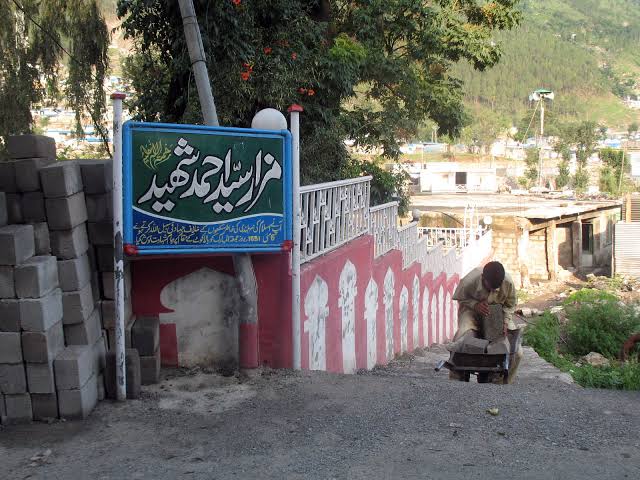Original Urdu article: Dr. Mubarak Ali, “Almiyah-e-Tarikh”, Chapter 11, pp.107-121, Fiction House, Lahore (2012).
Translated by: Rabia Aslam
Introduction
Syed Ahmad Shaheed Barelvi was born in Bareilly in 1786. After his initial education, he went to Lucknow at the age of 18 in search of a job but failed. He then decided to study at the Shah Abdul Aziz’s Madrassa in Delhi. He resided there from 1806 to 1811, then at the age of 25 he joined Amir Khan, a military expeditionary. In this regard, his biographers say that the purpose of his service in Amir Khan’s army was to acquaint him with practical military experiences so that they could be used in the preparation of jihad. But circumstances indicate that his financial situation was meager and he was striving for a job and, like the youth of his time, he joined Amir Khan’s army in the hope of gaining booty. There were opportunities, since this was the era of military adventurers in which warlords established their power by occupying territories through military might. Syed Ahmad spent seven years in the service of Amir Khan, who only fought to loot and plunder. He was unemployed again with 30,000 other soldiers when Amir Khan signed a treaty with the British East India Company in 1817. Syed Ahmad came to Delhi after the end of his service and from here he started his movement. He was joined by two members of the Shah Waliullah family: Shah Ismail Dehlavi (1771-1831) and Maulvi Abdul Hai (died 1828).
This movement began with the idea of revival of the notion of monotheism among Muslims in its pure and original form, and the fight against the ideas and customs that had corrupted Islam. Among them were Hindu rituals and vague Sufi and Shia beliefs. In order to make his movement known, he visited Doab areas in 1818 and 1819 and travelled to Ghaziabad, Murad Nagar, Meerut, Sadhana, Kandhila, Pholat, Muzaffarnagar, Deoband, Ganguha, Nanota, Bhoon (Police Station), Saharanpur, Rohailkhand, Lucknow and Bareilly. In 1821, he performed Hajj with a group of devotees. The aim was to revive this obligatory religious practice in India. Because of the occupation of the seas by European nations and the difficulties of sea travel, very few Indian Muslims went on Hajj and in view of these circumstances, some scholars had issued a fatwa that Hajj is not compulsory in these circumstances. Therefore, Syed Ahmad re-enacted the importance of Hajj among Muslims. After returning from Hajj in 1823, he once again visited different parts of India and, as it is written in his biography books, that people joined his movement by swearing allegiance to him in massive numbers. So the question is, what were the goals of his movement that attracted people?
Motivation
18th and 19th century India was politically, economically and socially fragmented. The Mughal Empire was disintegrating. The provincial powers became independent and engaged in civil wars. The British were slowly gaining ground in India. In Muslim elite, rulers and scholars, were insecure after losing their privileges. Although these conditions did not affect the ordinary Muslims, as they were already socially backward and had nothing to lose in further deteriorating circumstances. Therefore, the rulers and scholars were mentally strained due to the political instability, which was affecting the entire Muslim society of India. And the general feeling was that Muslims were losing hold and falling apart. The employees also endured hardships and were wiped out with the decline of political power of the Mughal Empire. Those who still performed their duties in such testing times, their salaries were not paid regularly, due to limited sources of income. Under these circumstances, Muslims joined the ranks of the military adventurers who roamed all over India for the purpose of plundering or fighting others on behalf of the rulers in return of money. But with the strengthening of British control, these groups could not hold ground and were wiped out. One of them was Amir Khan, (died 1834) who made peace with the British and took over the state of Tonk. Therefore, this treaty created unemployment among his predominantly Muslim soldiers. Among these unemployed soldiers, there was a group of clerics who had graduated from religious learning centers and for whom job opportunities were limited.
At a time when all the hopes to improve society were gone and the power was lost. The occupation of the estates had weakened, and the feeling of insecurity had engulfed the hearts. The mind was hollow and the thoughts were scattered, the future was dark. The emergence of a movement in such dark times of decline and despair in which there is hope for the future, which is promising to improve the situation, creates a new enthusiasm, passion and hope in the despairing hearts. The memory of the glorious past and the stories that are passed down from generation to generation always pinch the mind. Such emotions always fuel the revivalist movements.
Therefore, Syed Ahmad’s movement gave a purpose to the religious Muslims in that pointless environment and filled the gap in the lives of the masses belonging to the lower working class. They welcomed and invited Syed Ahmad to their small towns across India, and on these occasions, he tried to instill a purpose among the people through sermons. Because people’s lives did not go beyond their daily chores, this movement provided a platform to reclaim their celebrated past in the form of political power. Clerics and the middle class joined him in the hope that they could change the status quo.
The leaders of revivalist movements strive to form a community of their followers and to inculcate in them a spirit of unity through rituals and ideas. Syed Ahmad’s aim was to highlight the identity of Muslims in such a way that not only Hindu rituals were eradicated, but also Shia beliefs and Sufi influences were eliminated, so that they could unite and struggle towards a common objective.
The problem was, what should be the aim of the struggle. At this stage, the question arose as to whether India was “Dar-ul-Harab” (a state that is in conflict with Islam) or “Dar-ul-Islam” (a state that ensures religious freedom for Muslims) after the establishment of the rule of East India Company. Although the Mughal monarch was the head of the empire, administrative control rested with the East India Company. Muslims had complete religious freedom under the Company’s rule, despite this religious freedom, in view of some prominent Muslim scholars Indian-subcontinent had become “Dar-ul-Harab”, as infidel rituals were in practice without fear or hesitation. However, since Muslims had religious freedom, migration from their territory was not necessary.
On the contrary, some scholars believed that as long as any Islamic law and tradition remained, the area was “Dar-ul-Islam”. “Dar-ul-Harab’ is formed when Islam is completely wiped out from the region. However, another issue arose that if an area is “Dar-ul-Harab”, then it is necessary for Muslims to migrate to the area which is Dar-ul-Islam. Or should they wage jihad to convert “Dar-ul-Harab” into “Dar-ul-Islam” through it. Shah Waliullah argued that it was necessary to migrate from “Dar-ul-Harab” to “Dar-ul-Islam”. Any Muslim who refrains from migration will be guilty of committing a great sin. When the Jutts, Sikhs and Marathas occupied the Mughal territories, they were considered rebels and the occupied territories were considered “Dar-ul-Islam”. Thus, from Shah Waliullah’s point of view the Muslim wars in Indian-Subcontinent were jihad against the independent Hindu or Sikh states, and these states were termed rebellious. He also believed that if Muslims opted for peace and co-ordination with the rebel states, then they would be praising a cow’s tail (1).
In the time of Syed Ahmad Barelvi, India was under British rule. The rulers of the Muslim states were loyal to the British East India Company and the Muslims had no Imam or Caliph to declare jihad. Therefore, the decision was up to the different sections of the Muslim society. Therefore, those who benefited from the British rule called it “Dar-ul-Islam” and those who were harmed called it “Darul Harb”. For Syed Ahmad and the followers of the Faraizi movement, India was the capital of war and therefore jihad was obligatory for the Muslims (2). In his book, Sirat-e-Mustaqeem, Shah Ismail Dehlavi wrote:
“a large part of present-day India has become “Dar-ul-Harab. Compare the situation with the heavenly blessings of India two and three hundred years ago.” (3)
Here he was referring to the Delhi Sultanate and the Mughals, when the Muslim government in India was politically and militarily powerful and was consistently winning over the Hindus. Tribute income and taxes were plentiful, the elites were prosperous and free. But were Muslim people, including farmers, cultivators and artisans, also prosperous during those heydays? The answer to this question is not found in this book, because it was addressed to Muslim governors and feudal lords who were deprived of privileges and benefits after the Marathas, Sikhs, Jatts and the British came to power. He tried to motivate them for Jihad by writing:
“compare India with Rome and Turkey in terms of heavenly blessings” (4).
This suggests that at that time the Muslims of India had limited knowledge of world history and geography and of the Islamic countries themselves. Turkey and Rome were not two countries, but one country, then called the Ottoman Empire. In the 19th century, Turkey was a declining empire burdened with its own sins. But for the Muslim of India who were unfamiliar with the Ottoman Empire, God’s blessings were descending upon it. Since Syed Ahmad’s movement was based on jihad, “Sirat-e-Mustaqeem” attempts to create enthusiasm among the people by saying:
“as far as the special (sexual) benefits are concerned that go to the faithful Martyrs, the Muslim Mujahideen, the ruling Sultans and the brave men of the battle field, don’t need to be elaborated here”. (5)
When the time came to act for jihad, the Muslim rulers, the state and the feudal class, supported him financially but were not willing to go with him for jihad. The 8,000 Mujahideen (soldiers) who accompanied him were mostly clerics or middle-class people who joined in the hope that they would receive both heavenly rewards and material benefits. His movement was certainly supported by some of the rulers, most notably the states of Tonk, Rampur, and Gwalior, and these states did so because knew that the British would not stop them from doing so. None of them could have supported the movement without consent of the British.
Another question arises as to why they finally decided to wage jihad against the Sikhs? There were many reasons behind this:
1. They could not wage jihad against the British administration because the British were politically powerful and there was no chance of success against them and they would not have received any financial support either. Aid could be obtained for the war against the Sikhs.
2. They took up the border area because there is a general perception in northern India that the Pathans are great religious warrior and a martyr for the sake of religion. Therefore, Syed Ahmad and his followers may have thought that since their movement is purely religious, as soon as they would put their plan in front of them, the Pathans will immediately be ready to support them and help them. They will be able to fight effectively against the Sikhs. Since this war will be for religion, the Muslims of Punjab will also support them. Those involved in the jihad movement had zeal, enthusiasm, and were simple minded, and they hoped to defeat the Sikhs in the same spirit as the early Muslims had conquered Iraq and Iran in spite of their small numbers. And just as the scattered Arab tribes were religiously united, so will the Pathan tribes be united in one place. That is why Syed Ahmad Shaheed made jihad against the Sikhs a center so that he could gather his followers on it. He described the war against the Sikhs as a divine command which he expressed in one of his letters as follows:
“this humble servant of God has been commissioned to exterminate the infidels, that is, the long-haired Sikhs. In which there is no room for doubt, through benevolent glad tidings the virtuous Mujahideen have been appointed to give glad tidings to overcome them. Therefore, whoever does not spend his life, wealth, honor and justification today for the sake of the Word of God and the Sunnah of the Prophet (peace and blessings of Allah be upon him) will be forcibly reprimanded tomorrow and will have nothing but regret and shame” (6).
The reasons which were put to the fore in order to charge Muslims to wage Jihad against the Sikhs included:
(i) the threat to religious freedom for the Muslims,
(ii) mosques being used as horse stables,
(iii) Azan (call to prayer) being banned,
(iv) the Qur’an being desecrated, and
(v) Sikhs keeping Muslim women forcibly in their homes.
Some of these allegations were true and religious bigotry was expressed by fanatical Sikhs. But as a whole, there was a spirit of tolerance in Ranjit Singh’s government. There were a large number of Muslims in his administration and army. The government did not interfere in their religious affairs and their court cases were solved in accordance with Shari’ah. Therefore, the Muslims of Punjab did not support Syed Ahmad Shaheed.
In contrast, there were a large number of Muslims in the Sikh army who fought against him, and in the seventh war there were more Durrani Pathans than Sikhs who fought Syed Ahmad (7).
The campaign
Syed Ahmad and his companions started their journey in 1825, and entered the border area (Khyber Pakhtunkhwa) via Rajputana, Marwar, Sindh, Balochistan and Afghanistan and from there they sent a message to Ranjit Singh to
“either become a Muslim, pay Jizyah or fight and remember that in case of war, Yaghistan supports the Indians”.
Syed Ahmad fought his first war on December 21, 1826 at Akora Khattak. His army swept through and were comprehensively victorious. This victory boosted their morale and increased their influence in the frontier region. Therefore, it was decided that there should be a regular body for arrangements and other matters so that regular decisions could be taken in accordance with Shari’ah. In the light of this, on 11 January 1827, allegiance was sworn on his hand and he was elected Amir-ul-Momineen and was called by the title of Caliph.
Revivalist movements always try to reconstruct the ancient structure of the past and use ancient titles and terminology. Therefore, the terms like Amir al-mu’minin, Khalifa, Imam, Majlis-e-Shura, and Bait-ul-Mal were used. Syed Ahmad linked the events that took during his campaign with early Muslim history to inspire his followers. During a battle with Ventura, for example, he built a defensive wall and linked the battle to the Battle of Khandak, (the Trench War).
Syed Ahmad’s claim of Imamat (Caliphate) not only alerted his opponents in the Frontier region but also in India his claim was viewed with suspicion. When his name was read as Caliph and Imam in the sermon, it became clear to the Frontier chiefs that he wanted to deprive them of power and chieftaincy by establishing his own government in their area. Although he had tried to explain in his letters to India and other Muslim rulers that his aim was not to become a worldly leader but to become a chief for jihad against the infidels, he writes in the letter:
“We thank and praise God, the real master and the true king, who bestowed upon his humble, recluse and helpless servant the title of Caliphate, first through occult gestures and revelations, in which there is no room for doubt, and then by guiding the hearts of the believers towards me. This way God appointed me as the Imam (leader).” (8)
Criticizing his opponents, Shah Ismail Dehlavi wrote:
“therefore, obedience to Syed Ahmad is obligatory on all Muslims. Whoever does not accept the leadership of His Excellency or rejects it after accepting it, is an apostate and mischievous, and killing him is part of the jihad as is the killing of the disbelievers. Therefore, the appropriate response to opponents is that of the sword and not the pen” (9).
Regarding his Imamate, Syed Ahmad wrote to Nawab Wazir ud-Dawla, the ruler of Tonk:
“believe me, the person who sincerely confesses to my position is special in the eyes of God, and the one who denies it is, of course sinful. My opponents who deny me of this position will be humiliated and disgraced”. (10)
Syed Ahmad’s political and religious power created strong opposition against him in the Frontier region (now Khaybar Pakhtunkhwa). Because he with his forces suddenly came to the Frontier region and changed the whole political structure there, for which the chiefs were not ready at all. And most importantly, the Pathan chiefs and the people were unwilling to accept foreigners and strangers from northern India as their rulers.
Therefore, although Syed Ahmad’s battles were aimed against the Sikhs, he soon became more engaged in battle with the Pathan chiefs than with the Sikhs. And when some of them disobeyed him, he began to call them hypocrite, a weak believer, and accursed.
The Frontier chiefs had thought that they would reclaim their sovereignty by expelling the Sikhs with the help of Syed Ahmad. But when he elected himself Imam and Caliph, there was no difference between him and the Sikhs. Although Syed Ahmad Barelvi considered himself to be in a superior religious position, he still inspired his poor followers by mentioning the good news of victory, the acquisition of booty and the blessings of divine mercy. But power was dearer to the Frontier chiefs, who were unwilling to hand it over to Syed Ahmad in this way. The Pathan chiefs were by no means ready to give superior social status to the Maulvis. According to Khadi Khan, a Pathan sardar:
“it is the job of the Sardars to take care of the people, not a Maulvi who spends his life on donations. Maulvies are ill-equipped to run the affairs of a State”. (11)
After this opposition, it became necessary for Syed Ahmad to first secure his foundations and, when he had control over the whole area, establish Islamic law which is “Shari’ah”. Thus, his entire jihad movement turned into a civil war. So, when a series of battles broke out against the Frontier chiefs, Syed Ahmad justified the attack on their areas because he believed that there was immorality. The people had deviated from the Shari’ah and had the rituals of ignorance. In these circumstances, it becomes imperative for the Imam to wage war on such a state and put an end to their franchise rituals. To justify this the fatwa of Amir Timur was quoted in which the scholars of the time had justified the invasion of India. According to this fatwa, it is permissible to attack a country where there are un-islamic rituals, even if the ruler is a Muslim. In such a country, it is also permissible for the army to kill people and loot booty. (12)
The first battle in this regard was fought against Yar Muhammad Khan, the ruler of Yaghistan, who was killed in the battle, and in 1830, Peshawar was captured by Syed Ahmad. After that, Raees Panjtar and Sardar of Palal tribe became his disciples. But Sardar Pabandah Khan did not swear allegiance to him. Therefore, a fatwa of infidelity was imposed on him and a jihad was waged against him in which he was defeated. War was declared against Khadi Khan, another regional Chief, because he had revolted against Syed Ahmad after swearing allegiance, so he had to be killed. He was killed and Syed Ahmad refused to offer his funeral prayers, upon which the Pathan Maulvis offered his funeral prayers.
After the conquest of Peshawar, Syed Ahmad launched a violent policy to enforce Shari’ah and announced the abolition of all tribal rituals that he considered illegal. The most important of these rituals were: the bride was paid a regular price for marriage, the wives of the deceased were divided among his heirs, more than four marriages were practiced, women could not inherit property, internecine wars were considered jihad and plunder was considered booty. Therefore, after the conquest of Peshawar, orders were issued that those who can give half of the agreed money to the brides can take them. The young girls (9 year old and above) who are eligible for marriage should be married immediately. To enforce Shari’ah law, he appointed Imam Qutbuddin as an ombudsman, accompanied by 30 armed soldiers, who accompanied him to nearby villages to beat up the people who had abandoned prayers. Beatings and flogging had become the norm, that if the ombudsman went to any village, panic would spread. Punishment was carried out with extreme violence and people were even hanged on tree branches.
Even among women, those who missed prayers were punished in the women’s quarters, so people soon became fed up with these polices because these judges and ombudsmen started harassing people and imposed fines on them beyond their means. (13)
What angered the Ulema of the Frontier was the collection of ‘Ushur’ religious tax (the tenth of the agriculture produce) by Syed Ahmad and Mujahideen, because the Ulema of the Frontier were still entitled to it. The Mujahideen said that the Imam is entitled to it and he collects it in the treasury and distributes it among the deserving. As this affected the livelihood of the Ulema of the Frontier, they became fierce opponents of them. This opposition was later exacerbated by their beliefs, which included Amen al-Jahr (saying Amen aloud) and Rafa’ ul-Yaddain (raising the hand in prayer). In addition, the clerics in India who disagreed with him sent a declaration stating that Syed Ahmad was an agent of the British, so beware of him. (14)
Ulema, Fronteir Chiefs and the general public began to feel uneasy when the Mujahideen, most of whom had not brought their families with them, started forced marriages in Pathans. It even happened that a girl was seen in a street and a Mujahid caught hold of her and took her to a mosque and forcibly married her. When an Indian man thus married the daughter of a Khushiki chief, he asked the chief of his rival Khattak tribe to help him. At this, the Khattak chief took off his daughter’s dupatta (veil) in front of the tribe and vowed that he would not be in peace until he avenged the honor of the Pathan. (15)
Ironically, the girls of the families who got married to these Indians were ridiculed by other Pathans for marrying black-clad Indians, and the Mujahideen punished those who ridiculed them. (16)
These were the reasons why the Ulema, Sardars and the people of Frontier turned against Syed Ahmad and under a plan they killed all the Mujahideen who were in charge of administrative affairs in and around Peshawar. After this incident Syed Ahmad decided to flee to Kashmir, but before reaching there he was ambushed by the Sikhs and in 1831 he was killed with his comrades at Balakot.
Causes of failure
A critical examination of Syed Ahmad’s Jihad movement reveals its fundamental weaknesses. Before making the Frontier area his center, neither Syed Ahmad nor his followers understood the geography of the area or its history. Nor the formation of tribes, their traditions, customs and minds.
Neither did they learn their language nor their ways. They did not realize that linguistic and tribal ties were stronger than religion. And Pathans would have never made those who came from northern India their rulers. Because although religion was the same, but cultural differences remained an obstacle in bringing them closer to each other. With the help of the Mujahideen and volunteers who came with him, it was difficult to defeat the tribes and establish a government there by force. Therefore, his activities were viewed with suspicion by the Pathans from the very beginning and it was difficult for the local populace to understand why these people had come from India to wage jihad. Ismail Shaheed realized this and expressed it in this way:
“although our ultimate goal was to please God, but it was not the right time for the army to come to this area. All that was needed was for a missionary to come to the area with a few disciples and make secret and public visits to the villages and settlements. The Islamic army should have followed after the chiefs of the area were ready and a focal point for the army was fixed. If not so then at the very beginning, an overwhelming army of brave men would turn around and raise the banner of Jihad, regardless of the agreement or opposition of the people, and would attack the infidels and hypocrites without any hesitation”. (17)
Besides, not all those who came with him were sincere with the mission. There were also numbers that came for the sole purpose of looting, they included soldiers who were part of the former Amir Khan’s army. Fighting was their profession and through it they amassed wealth. When the opportunity for adventure in India ran out, they came to the tribal areas in the hope that they would both doing service to religion and looting booty. At the same time, there was evidence that those taking part in jihad had no military training. There was no discipline. Besides that, they had to rely on Indian donations for military spending and arms. In the beginning, people donated a lot, but when the chances of success reduced, so did the donations.
Therefore, it can be said that this movement was started with religious fervor and it was formed on assumptions. The realities were ignored. Movements do not succeed by mere zeal and violence and prejudice. And as a result, society loses its strength and energy.
Legacy
Syed Ahmad Barelvi’s movement did not achieve any success against the Sikhs nor was it possible to establish an Islamic state in the Frontier. When the Punjab was annexed by the British in 1849, they sternly suppressed the movement and his followers were subjected to “Wahhabi trials” until 1870 in which the scholars involved were given various punishments. In the end, Maulvi Muhammad Hussain Batalvi reconciled with the British government by naming it Ahle Hadith and also wrote a pamphlet against Jihad. Some of the features of Syed Ahmad’s movement were that it was purely an Indian movement and it didn’t come from outside. All donations for this movement were collected from India, which created a sense of religious segregation in Indian society in India, and it stopped the growth and spread of Mughal culture, which was emerging as a secular culture.
The impact of failure of this movement was that the Ulema started preaching missions instead of jihad and established madrassas and seminaries to secure their influence. This movement also created deep divisions in the class of Indian Islamic scholars and these differences became more intense in the form of religious debates and sermons. Therefore, the Ulema and their followers disassociated themselves from the movement and even celebrated their defeat. And the result of this movement was the same as that of most revivalist movements, which, instead of creating unity among Muslims, caused divisions and prompted the formation of new sects. Instead, the imprint of these religious conflicts and differences is still present in religious parties and groups.
References
(1) Shah Waliullah, Hujatullah-al-Balagha, p. 28, Karachi, 1926.
(2) Peter Hardy, Indian Muslims, p.109, Cambridge, 1982.
(3) Shah Ismail Dehlavi, Sirat-e-Mustaqeem, p. 49.
(4) Ibid, p. 50,
(5) Ibid, p. 51.
(6) Jafar Thanesari, Maktoobat-e-Syed Ahmad Shaheed, p. 44, Karachi, 1949.
(7) Mirza Hairat Dehlavi, Hayat-e-Tayyaba, p. 261.
(8) Maktoobat Syed Ahmad, p. 119.
(9) Ibid, p. 175.
(10) Ibid, p. 295.
(11) Abul Hasan Nadvi, Seerat-e-Syed Ahmad Shaheed, pp. 114-115, Karachi, 1975.
(12) Mirza Hairat Dehlavi, Hayat-e-Tayyaba, pp. 383-384.
(13) Maktoobat Syed Ahmad, pp. 277, 280.
(14) Obaidullah Sindhi, Shah Waliullah ki Siyasi Tehreek, pp. 96-102, Lahore, 1951.
(15) Abul Hassan Nadwi, Seerat Syed Ahmad Shaheed, p. 212.
(16) Ibid, 46
(17) Mirza Hairat Dehlavi, Hayat-e-Taiba, p. 260.








